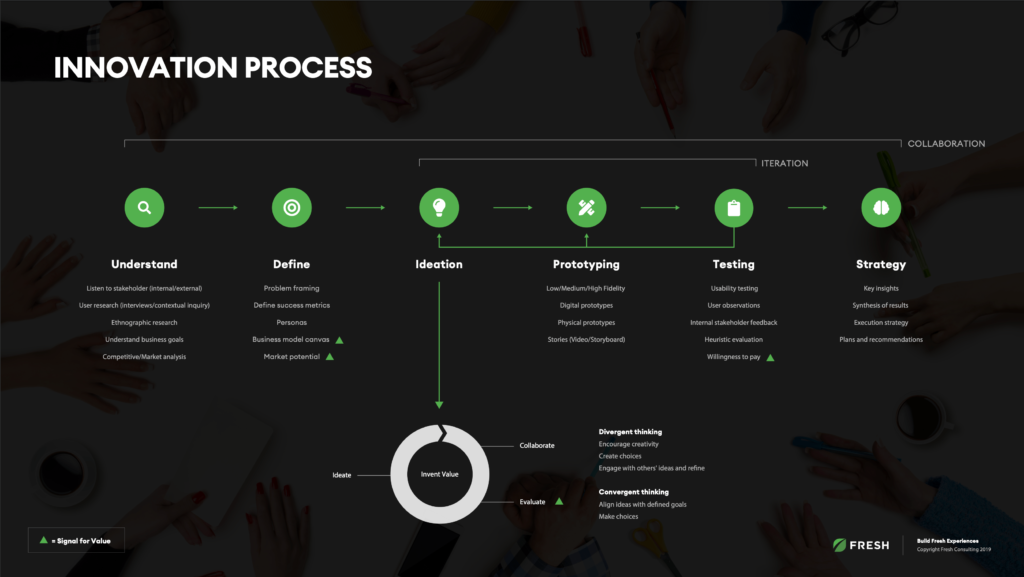Article
Design Is Not the Solution—it is the Process

At Fresh, we think a lot about creating great products and client relationships. We’ve found our success is highly correlated to working from defined and proven processes. Defining and communicating our process is critical to aligning our team and our clients on expectations, strategy, roles, and values. And we’re not the only ones—our process graphics are our #1 downloaded resource, so we know that process is important to you as well!
In this article, we’ll discuss why process is so important, look at some common misconceptions, and share tips to make your processes work better for you.
A defined process helps us reach consensus and vanquish disagreement. To illustrate the value of a holistic user experience (UX) design process, Fresh created an interactive website called Defeat BOCO (Beast of Conflicting Opinions).
Because you address similar problems regularly, you will have developed a formalized process for achieving success.
During your next project kickoff, use your process to make the case that the consistency of your outcomes comes from the strength of your process and that you must, therefore, be permitted to use it. Clients will relinquish control once they’re confident the experts have a proven process to achieve successful outcomes.
Process Shouldn’t Limit Creativity
Why Do Creatives Resist Process?
It’s common for creatives to resist routine and process. Since each project is different, it’s logical to feel that a pre-defined process is rigid and limiting. But while creatives may dislike routine, the client—and any consistency of success—demands it.
The challenge of thinking you understand something that you don’t is common. Researchers call this ‘the illusion of knowledge.’ This illusion is often a barrier to knowledge because it’s easy to assume you know more than you do. The challenge when you’re first starting is you don’t know what to do. The challenge when you’re a veteran is that you think you already know what to do.
“The greatest obstacle to discovery is not ignorance—it is the illusion of knowledge.” – Stephen Hawking
The longer we do things, the more we rely on routine and habit. We rerun old routines and old ways of solving problems out of habit rather than conscious choice. This isn’t necessarily bad, but it could mean that we have blind spots. The act of mapping out a process helps us spot inconsistencies and identify activities that don’t align with your principles.
Process Isn’t a Prescription
Given the blowback against the Waterfall approach to project management, some hostility towards process is warranted. In some organizations, executives create prescriptive, formulaic processes in silos. They see these processes as a tool to (micro) manage people and product development. In these systems, people must conform to the processes and tools. But conformity makes it hard to accommodate fresh ideas, requirements, and perspectives. If the process drives the team, the team can’t respond to change and is less likely to meet customer needs.
The process for a startup that needs to launch a successful product will differ from a large risk-averse financial institution. Our processes follow a set of basic steps, but they’re also fluid. Don’t think of your process as a regimen to follow, but as techniques and principles that help the team solve a unique problem.
Process Making Tips
Discover Improvements
When you document your process, you’ll often find inefficiencies and areas for improvement. Should you test after design, after development, or both? Are you doing a post-mortem after each project? Should you prioritize features before or after ideation? These things become clear when you spend a little time reflecting on what’s worked and what hasn’t.
Make It Visual
Half of the human brain is directly or indirectly devoted to processing visual information. A process graphic helps clients see where they are in the overall engagement. Without this, clients will feel uncertain and anxious about the timeline and budget. Visually showing your methods helps establish trust and confidence throughout the engagement.
Build the Process Around Your Values
Your design process is more than the stages of your workflow—it’s your strategy and values, too. What’s important to you? Do you feel that design should solve for the genuine needs of end-users, rather than putting lipstick on the pig? Then bake real research into your process. Do you believe ideation and prototyping are important to achieving successful outcomes? Then add them. Do you want to be sure that the problems you’re solving are real problems? You know what to do!
Keep It Iterative
While it is important to think about the logical order for each phase in your process, your process must remain flexible and iterative. During the prototyping and testing phases, iteration is a given! But you can, and should, use iterative design principles at any phase of the process. We’ve found it helpful to build in iteration, ideation, and rapid prototyping into our processes to make sure we’re able to adapt to new information and ideas as they arise.
We owe it to ourselves and our clients to define and communicate our process. Our clients’ results depend on it.









